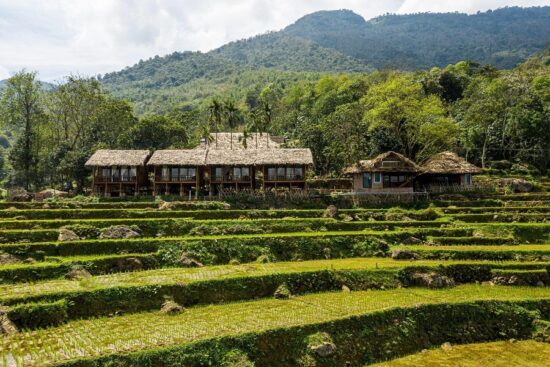- You are here:
- Home »
- About Sapa »
- OVERVIEW OF LAO CAI TOURISM (Part 3)

OVERVIEW OF LAO CAI TOURISM (Part 3)
BAO YEN – THE SACRED LAND
Bao Yen District, the Southern gateway of Lao Cai Province, benefits from convenient transportation on National Highways 70 and 279, the Noi Bai – Lao Cai Expressway and the Hai Phong (Vietnam) – Kunming (China) railway. In the near future, Sapa Airport will connect Bao Yen and Lao Cai to the rest of the country and international tourists. With its beautiful natural landscape, hospitable people and rich, unique culture, Bao Yen has great potential for developing spiritual and community tourism.
Coming to Bao Yen, visitors can immerse themselves in the sacred atmosphere of praying for national peace and happiness for their families; experience festivals and vibrant cultural life of ethnic groups in the first and seventh lunar months; or explore the lush nature, fragrant rice fields and cool streams in March – May and August – September at the community tourism spots of Nghia Do commune. Throughout the year, visitors can explore the unique culture associated with local agricultural activities, enjoy the pristine nature of mountains and rivers and experience the warm hospitality of the honest and kind people.
BAO THANG – THE LOVE OF THE LAND AND PEOPLE
Bao Thang District is a border district of Lao Cai province, with an area of over 640 km², including 11 communes and 3 towns, a population of about 113,000 people, including 20 ethnic groups living together in harmony, a revolutionary homeland imbued with love for the country and humanity.
Bao Thang boasts beautiful natural sites such as Đầu Nhuần Waterfall, Bắc Ngầm Cave Complex, and hot springs. It is rich in historical and cultural relics, including Liên Hoa Temple, the Phố Lu Historical Site, and the Sơn Hà archaeological site. Visitors can explore charming community tourism villages like Bản Cam (Gia Phú Commune) of the Dao Đỏ ethnic group, Nậm Trà Village (Gia Phú Commune) of the Xa Phó ethnic group, and Phú Nhuận Commune of the Tày ethnic group. With its well-developed transportation system and diverse tourism potential, Bao Thang meets the demands of curious travelers.
Bao Thang boasts beautiful natural sites such as Dau Nhuan Waterfall, Bac Ngam Cave Complex and hot springs. It is home to many historical and cultural relics, including Lien Hoa Temple, Pho Lu Historical Site and Son Ha Archaeological Site. Visitors can explore charming community tourism villages such as Cam Village (Gia Phu Commune) of the Red Dao ethnic group, Nam Tra Village (Gia Phu Commune) of the Xa Pho ethnic group and Phu Nhuan Commune of the Tay ethnic group. With a well-developed transportation system and diverse tourism potential, Bao Thang meets the needs of curious visitors.
VAN BAN – THE LAND OF ENDLESS FORESTS
Located in the South of Lao Cai province, Van Ban is the second largest district in area, home to 11 ethnic groups, of which the Tay ethnic group is the largest (over 48%). Notably, Van Ban is the only district in Lao Cai where the Green Hmong reside, one of the four branches of the Hmong ethnic group in Vietnam
Van Ban still retains large areas of primeval forests in the communes of Nam Tha, Liem Phu and Nam Xe, with diverse forest ecosystems, ideal for nature exploration and hiking. The district is home of beautiful waterfalls such as Bay Waterfall, Tham Duong Waterfall and Nam Tha Waterfall. Many localities still preserve the traditional cultural values of the Tay and the Red Dao people. For the Tay people, the cultural heritage passed down through many generations remains intact. Traditional stilt houses in communes such as Chieng Ken, Duong Quy and Khanh Yen Trung attract tourists. Local cuisine, including black sticky rice cakes, fish dumplings, fern salad and grilled fish are prepared by skillful hands, highlighting the culinary culture of Van Ban.
The area is also enriched by verdant forests, spiritual practices honoring the Mother Goddess of Forests and the sacred allure of ancient temples like Tan An Temple and Chieng Ken Temple.
SI MA CAI – GLIMMERING BORDERLANDS
The name “Si Ma Cai” comes from the Hmong language “Xênh Mua Ca” means “New Horse Market”.
Si Ma Cai is a land rich in cultural traditions and creative labor, despite challenging production conditions. The Hmong people in Si Ma Cai have experience and techniques for intensive corn cultivation in high mountains and rocky terrain, creating lush, high-yield corn fields. In the lower regions, the Nung people have transformed desolate valleys into fertile rice fields. In addition, ethnic communities in Si Ma Cai have developed valuable traditional crafts, such as Hmong blacksmithing, weaving and linen embroidery.
Festivals in Si Ma Cai have unique cultural elements, including those of the Nung and the La Chi ethnic groups, emphasizing nature, forest conservation and environmental protection. Notable examples include the “Say San” festival and the Hmong forest worship rituals which have profound educational significance. Si Ma Cai ethnic culture is most vividly expressed in local markets which are not only centers of economic exchange but also cultural gathering places. In particular, the markets in Si Ma Cai still retain their indigenous charm with famous stewed thang co and rice wine.
The Si Ma Cai border area with its colorful flowers, warm sunshine and hospitable people always welcomes visitors from near and far with open arms.
To Uyen
About the Author Sapa Tourism Office
Popular posts

